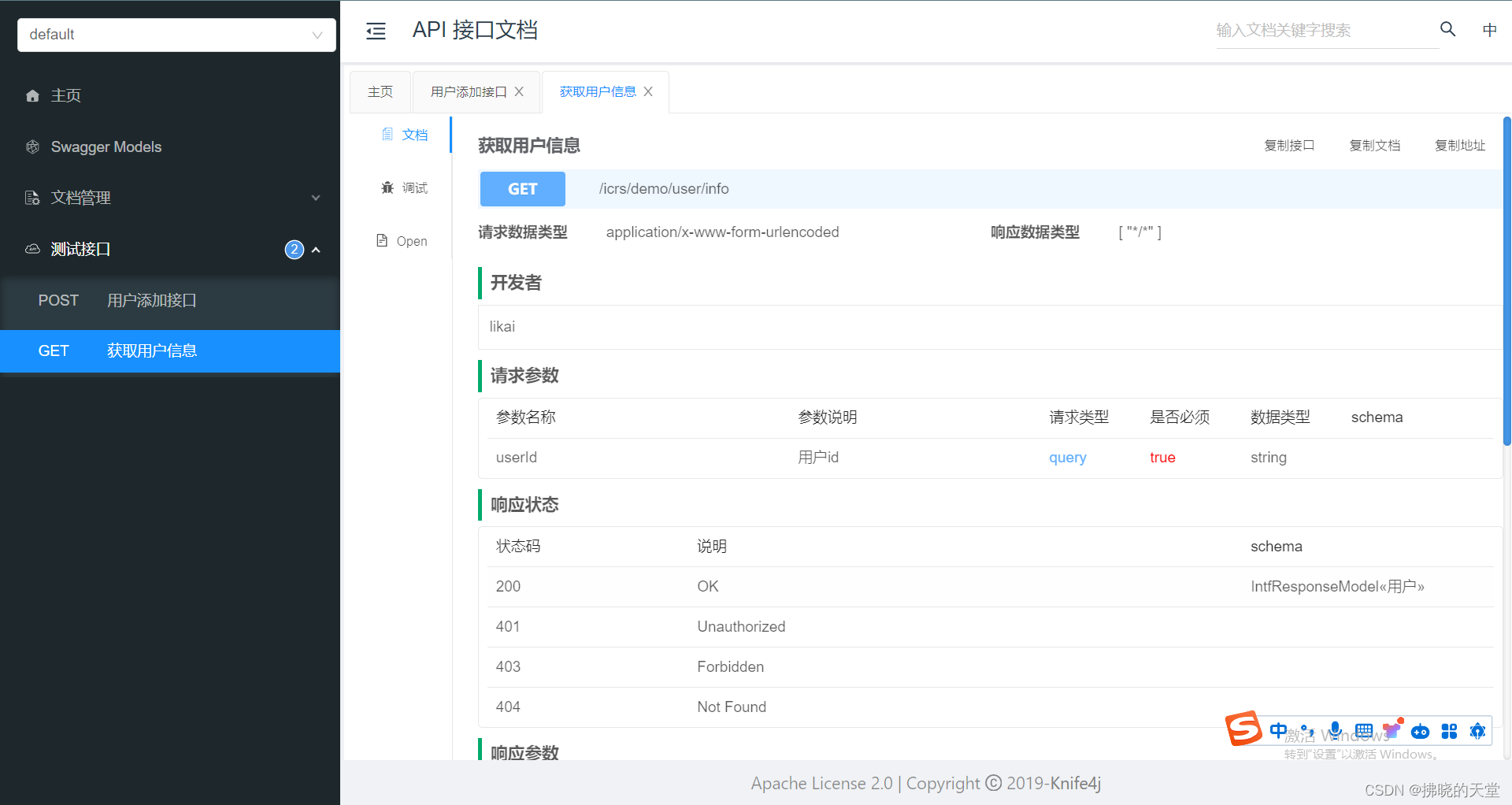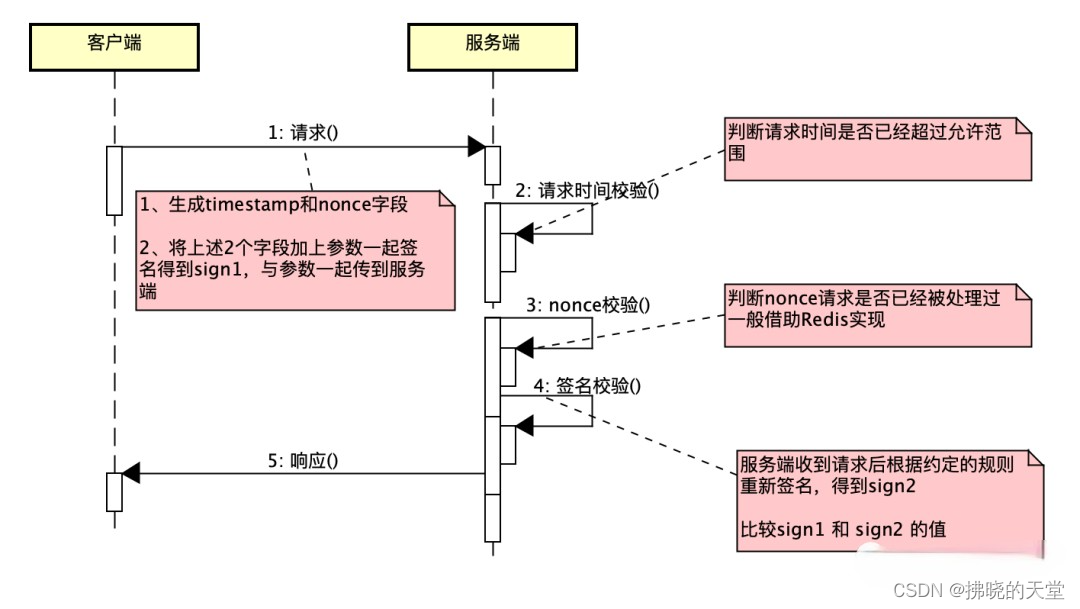springboot使用的是2.6版本,首先添加knife4j maven,springfox的包删掉
<dependency>
<groupId>com.github.xiaoymin</groupId>
<artifactId>knife4j-spring-boot-starter</artifactId>
<version>3.0.3</version>
</dependency>
<!-- <dependency>-->
<!-- <groupId>io.springfox</groupId>-->
<!-- <artifactId>springfox-boot-starter</artifactId>-->
<!-- <version>3.0.0</version>-->
<!-- </dependency>-->添加application.yaml
mvc: pathmatch: matching-strategy: ant_path_matcher
添加swagger配置类,swagger.enable如果配置的话可以打开
@Slf4j
@Configuration
@EnableSwagger2WebMvc
//@ConditionalOnProperty(name = "swagger.enable", havingValue = "true")
public class SwaggerConfig implements WebMvcConfigurer {
@Bean
public Docket createRestApi() {
return new Docket(DocumentationType.SWAGGER_2)
.apiInfo(new ApiInfoBuilder()
.title("API 接口文档")
.contact(new Contact("cnbai", "https://blog.csdn.net/baihaibo1024", ""))
.version("1.0")
.build())
.select()
.apis(RequestHandlerSelectors.withMethodAnnotation(ApiOperation.class))
.apis(RequestHandlerSelectors.basePackage("com.coscoshipping.api.demo"))
.paths(PathSelectors.any())
.build();
}
@Override
public void addResourceHandlers(ResourceHandlerRegistry registry) {
registry.addResourceHandler("/**").addResourceLocations("classpath:/static/");
registry.addResourceHandler("swagger-ui.html").addResourceLocations("classpath:/META-INF/resources/");
registry.addResourceHandler("doc.html").addResourceLocations("classpath:/META-INF/resources/");
registry.addResourceHandler("/swagger-resources/**").addResourceLocations("classpath:/META-INF/resources/");
registry.addResourceHandler("/webjars/**").addResourceLocations("classpath:/META-INF/resources/webjars/");
}
}重写BeanProcessorConfig类防止Failed to start bean 'documentationPluginsBootstrapper'; nested exception is java.lang.NullPointerException 异常
@Configuration
public class BeanProcessorConfig {
@Bean
public static BeanPostProcessor springfoxHandlerProviderBeanPostProcessor() {
return new BeanPostProcessor() {
@Override
public Object postProcessAfterInitialization(Object bean, String beanName) throws BeansException {
if (bean instanceof WebMvcRequestHandlerProvider || bean instanceof WebFluxRequestHandlerProvider) {
customizeSpringfoxHandlerMappings(getHandlerMappings(bean));
}
return bean;
}
private <T extends RequestMappingInfoHandlerMapping> void customizeSpringfoxHandlerMappings(List<T> mappings) {
List<T> copy = mappings.stream()
.filter(mapping -> mapping.getPatternParser() == null)
.collect(Collectors.toList());
mappings.clear();
mappings.addAll(copy);
}
@SuppressWarnings("unchecked")
private List<RequestMappingInfoHandlerMapping> getHandlerMappings(Object bean) {
try {
Field field = ReflectionUtils.findField(bean.getClass(), "handlerMappings");
field.setAccessible(true);
return (List<RequestMappingInfoHandlerMapping>) field.get(bean);
} catch (IllegalArgumentException | IllegalAccessException e) {
throw new IllegalStateException(e);
}
}
};
}
}新建测试用DTO
@Data
@NoArgsConstructor
@AllArgsConstructor
@ApiModel(value = "用户",description = "用户对象模型")
@ToString
public class DemoUser implements Serializable {
private static final long serialVersionUID = 7497034210240490279L;
@ApiModelProperty(name="id",value = "用户Id",dataType = "Long")
private Long id;
@ApiModelProperty(name="name",value = "用户名",dataType = "String")
private String name;
@ApiModelProperty(name="age",value = "年龄",dataType = "Integer")
private Integer age;
@ApiModelProperty(name="deleted",value = "是否删除",dataType = "Boolean")
private Boolean deleted;
@ApiModelProperty(name="birthday",value = "生日",dataType = "Date")
private Date birthday;
}@ApiModel 用来描述实体
@ApiModelProperty 用来描述成员对象
常用注解具体的可以参考下面这个文章:
Swagger常用注解 - 三分恶 - 博客园 (cnblogs.com)
接着为全局通用返回类添加注解:
@Data
@NoArgsConstructor
@AllArgsConstructor
public class IntfResponseModel<T> {
@ApiModelProperty(name="code",value = "状态 200:成功 其余异常",dataType = "int")
private int code;
@ApiModelProperty(name="message",value = "错误信息",dataType = "String")
private String message;
@ApiModelProperty(name="data",value = "返回数据主体")
private T data;
public static IntfResponseModel newInstance(InterfaceResponseCodeEnum interfaceResponseCodeEnum){
IntfResponseModel intfResponseModel = new IntfResponseModel();
intfResponseModel.setCode(interfaceResponseCodeEnum.getCode());
intfResponseModel.setMessage(interfaceResponseCodeEnum.getMessage());
return intfResponseModel;
}
public static IntfResponseModel success(String data){
IntfResponseModel intfResponseModel = new IntfResponseModel();
intfResponseModel.setCode(InterfaceResponseCodeEnum.INF_200.getCode());
intfResponseModel.setMessage(InterfaceResponseCodeEnum.INF_200.getMessage());
intfResponseModel.setData(data);
return intfResponseModel;
}
public static <T> IntfResponseModel<T> success(T data) {
IntfResponseModel intfResponseModel = new IntfResponseModel();
intfResponseModel.setCode(InterfaceResponseCodeEnum.INF_200.getCode());
intfResponseModel.setMessage(InterfaceResponseCodeEnum.INF_200.getMessage());
intfResponseModel.setData(data);
return intfResponseModel;
}
public static IntfResponseModel error(Integer code, String message){
IntfResponseModel intfResponseModel = new IntfResponseModel();
intfResponseModel.setCode(code);
intfResponseModel.setMessage(message);
return intfResponseModel;
}
public int getCode() {
return code;
}
public void setCode(int code) {
this.code = code;
}
public String getMessage() {
return message;
}
public void setMessage(String message) {
this.message = message;
}
public T getData() {
return data;
}
public void setData(T data) {
this.data = data;
}
}这里要注意不要为全局返回类添加@ApiModel,因为内部的data才是文档需要描述的对象,另外getData最好不要用lombok自动生成的,因为这里需要getData返回T,lombok自动生成的getset返回的是Object。
写个测试接口
@RestController
@RequestMapping("/demo")
@Api(tags = {"测试接口"}, description = "测试接口")
@Slf4j
public class DemoController {
@ApiOperationSupport(author = "xxx")
@GetMapping("/user/info")
@ApiOperation(value = "获取用户信息")
@ApiImplicitParam(name = "userId",value = "用户id",required = true,paramType = "query",dataType = "string")
public IntfResponseModel<DemoUser> userInfo(@ApiParam("userId") @RequestParam(value = "userId", required = true) String userId){
DemoUser result = new DemoUser();
return IntfResponseModel.success(result);
}
@ApiOperationSupport(author = "xxx")
@PostMapping("/user/add")
@ApiOperation(value = "用户添加接口")
public IntfResponseModel<Boolean> addUser(@RequestBody DemoUser user){
log.info(user.toString());
return IntfResponseModel.success(Boolean.TRUE);
}
}启动后访问127.0.0.1:8080/doc.html

接口文档,调试,接口导出功能三块,其中接口导出可以导出通用的openApi协议,支持导入到YAPI或者postman中,方便测试同学测试。
另外接口安全部分可以自行实现APO拦截进行鉴权验签校验,防止非认证请求和接口重放攻击,流程参考下图:

如果接口暴露在外网,接入内网网关的话也建议在后端做校验,可以通过referer判断是外网请求或是内部请求,在AOP中选择不同的校验方式,如外网请求用验签,内网请求用透传token判断,按需求灵活设置。





















 609
609











 被折叠的 条评论
为什么被折叠?
被折叠的 条评论
为什么被折叠?








